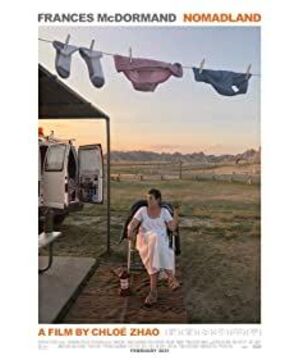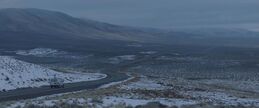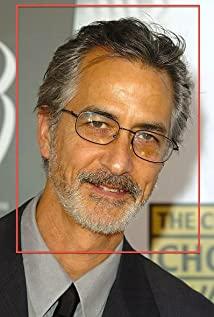Author: pASslosS
Since last year, he won the Golden Lion award, Zhao Ting this "helpless land" has become many fans looking forward to the work. Judging from the current data, "A Place of Nowhere" has won 27 awards in the award season, leading other films by a large margin.
However, in addition to the expectations of the film, "A Place Without a Foothold" has faced many controversies until now. Regarding the controversy about the director himself (wrote it in detail before, click here to view), the film style alone has to be ridiculed to imitate Terrence Malik , or it is not as obvious as Ken Rocky ’s political nature and even more absurd. Yes, even with Zhao Ting's predecessor, "Knight", there is a partial continuation of the style, and it has to be complained about without "innovation".
But today’s article is not to tear down the details. I prefer to use my life experience to connect with the film rather than using my past experience of watching movies to review the film, and then I found out that they are heading towards. The road is not a way of escape, but a beacon for the suffering that everyone may suffer in the future.
The story began in the winter of 2011. Due to reduced demand for gypsum board, American Gypsum Company closed its 88-year-old factory in Ampier, Nevada.
Subsequently, Ampier postcode 89405 ceased operations, which means that the entire town will also be closed. This situation has left hundreds of local workers homeless. In order to survive, they rushed to all parts of the country to build temporary communities in mobile crowds and spaces.
The film is adapted from reporter Jessica Bruder ’s documentary work "A Place to Nowhere : Living in the 21st Century America" . The book records these elderly Americans living in station wagons and vans. They are like those in the past. Modern migrant workers also migrate with the seasonal call of temporary work.
All the actors in Zhao Ting's previous works " The Song That My Brother Taught Me To Sing" and "The Knight" are locals. There are still many faces of non-professional actors in this "A Place of Nowhere".
So under Zhao Ting’s lens, there are both the real nomads described in the book and the wandering people who came across during the shooting. For example, this film is more like a free dialogue and continuation of Bruder’s work. It is not a simple application and remake.
At the beginning of "A Place of Nowhere ", Fern took out his belongings from the locker, stuffed his soul and daily necessities into the car, holding his late husband's work clothes and couldn't control his sadness.
This is a farewell ceremony with an oriental charm, and then she will drive a van through a cold wasteland in Nevada, whose destination is a large warehouse in the Amazon. This temporary job will support her and other temporary workers through the cold winter months.
The film mentions trying to get rid of the "yoke of dollar tyranny", but this kind of getting rid of it is difficult to follow. Many of them have reached the retirement age, but they have no intention to retire and still choose to support themselves.
Fern is a manifestation of this duality. She is indeed a victim of the economic crisis, but she refuses to show the emotion of being "knocked down by life".
These people no longer struggle to maintain what they once owned because the cost of "maintaining" is quite high. Instead, they focus on reducing demand. But this way of life is accompanied by dangers. For example, they will freeze to death in the car, and they may not be able to get out of no man’s land without a spare tire.
This means that they did not choose an easier life on the road, let alone to escape. Whether it was due to their own choice or forced helplessness, these people have become numb to the temptations of career, property, class, etc., and turn to seek. A kind of "freedom" with a high risk factor .
But this "freedom" depends on packing couriers in Amazon warehouses, loading baskets of beets on trucks, working as a mild cleaner in a caravan park, or busying amidst a pile of fries and burgers.
Human value and work are not cause and effect. A typical example is Fern, because she has enough experience and ability to teach or be a manager.
Economic recession, rising housing costs, failure of the social security system... However, Zhao Ting did not reduce these lively people to by-products of cold capitalism, nor did he boldly capitalize the “failed” part of the social system. .
Because even in this situation, people still have room to go on their way, not the dead bodies in the capitalist cage.
It is precisely this point that makes "A Place of Nowhere" present the backside of Ken Rocky's accusation perspective. There is no high or low difference between these two methods, and there is no need to be criticized for choosing only one perspective.
Although "Nowhere" does not have enough angry condemnation, sadness is another embodiment of anger, because these people are completely tired of lies and "rebellion against exploitation."
Fern belongs to the working class, often outspoken, can't stand anyone's mercy, and even seems unkind.
But this character also has some details that are full of surprises, as she sits in a van practicing flute and recites the eighteenth Shakespeare sonnet for the young tramp.
Self-destruction and candid enthusiasm appeared in Fern at the same time , and Francis McDormand could show this complexity with a look or a wry smile. She enters the role without becoming a narrative pawn.
This ambiguity of not making moral judgments on the characters allowed me to see the shadows of "The End of the World" and "The Gleaner" . Varda's camera does not exist to target the vagrants and scavengers, but is digging into life. The rich logic of the body itself.
These logics are often contrary to our life experience, but they help to broaden people’s definitions of many words, such as poverty, wandering, and being abandoned... In the role of "A Place of Nowhere", these words are full of life. "organism".
Of course, there are also some unforgettable supporting roles and stories in the film, such as Swanky and Linda May , who are about the same age as Fern . As experienced travelers, they guide Fern to communicate more thoroughly with nature and trauma.
And Dave 's appearance and departure also made Fern understand that she could not stay in other people's habitats.
Sometimes people think that a person chooses to leave or stay because of another "person". In fact, it's more than that, because the house is also another manifestation of human spirit and flesh.
When the camera followed Fern carefully to observe every corner of Dave's house, everything was already clear-Fern left because he was completely unfamiliar with everything in this room. This was another world belonging to Dave, and she didn't want to touch and blend in.
Fern's obsession with cars is the same, because that is another incarnation of her.
In addition, the circular narrative structure in the film is also in line with the natural pace .
Leaving and returning are executed at the same time. The film retraces the landscape described by Bruder in the book while stroking the 21st century capitalist landscape.
Those on the road flow between the two. Half of them are instrumentalists in the capital market, and half are devoted to primitive freedom, with their front feet retreating, and back feet returning, and they will never really bid farewell.
The possibility of nomads lies in the invocation of time, just like light. People can interpret everything they miss as "light" that has not yet reached their hands.
And this natural fit is also reflected in the soundtrack, the soundtrack of the film mostly excerpts from the Italian contemporary classical composer Ludovico Einaudi (Ludovico Einaudi) works. They start with quiet piano music and gradually evolve into a carefully arranged range.
These soundtracks are not tailor-made for "A Land Without a Dependence", but Zhao Ting specially selected them for the film.
Most of the music she chose comes from an anthology called "Seven Days Walking" , which contains 7 albums, from Day1 to Day7, inspired by Ludovico Inode's hiking in the Alps.
He walked back and forth along the same road for 7 days, facing the ever-changing climate, light, temperature, and wild animals, making completely different emotional connections.
Zhao Ting matched the musician's journey with Fern's changing inner state, because the commonality is "inspired by nature", whether it is music or behavior.
For example, Fern chose "Day 1-Golden Butterflies" in the background music when he walked in the camp for the first time and greeted all strangers;
The two farewells with Dave are selected from "Day 3-Low Mist";
The "closed loop" of the journey is also contrasted in the music. The first time Fern hits the road and the end returns to the abandoned homeland are the same "Oltremare";
And after she bid farewell to Swankey, it was "Petricor".
Swanky was suffering from cancer and died soon after, but no one said goodbye to her, just threw stones into the fire, as if she was waiting for them in a certain time and space.
In fact, no matter for a person or a group, "home" is a fluid concept. Sometimes when looking for this home, you don't have to rely on "consolidating barriers", but let yourself go down the river.
Zhao Ting has also found her own "flow". She connects the fleeting happiness and solid heartache with the mystery of nature. This makes the process of watching "A Place Without a Reliance" like gazing at once and immersed in eternity. Sunset.
In addition, the reason why "Nowhere" resonates is because it seems to be a response to the turmoil and anxiety in 2020.
This is a year that makes many people (including us) feel even more confused. They don't know where to go next, and they don't know what will happen tomorrow. "A Place of Nowhere" shows humility when facing this proposition. It tries to cross the boundary between fact and fiction, and unfolds a desolate and gentle description. It allows real people to interpret their beautified version poetically to reach a deeper level of reality.
Finally, Fern returned to the deserted Nevada town and home where she had lived for decades. The film ended in vastness and desolation. Her trauma was accurately exposed in the form of space, and we finally saw the reason why Fern had to go on the road. .
Withdraw from the mainstream society, open up one's own path, shape a new identity, and become an exile and a pilgrim at the same time... This film seems to bring up the possibility that if the world is difficult, people can still try to return to eternity.
View more about Nomadland reviews











